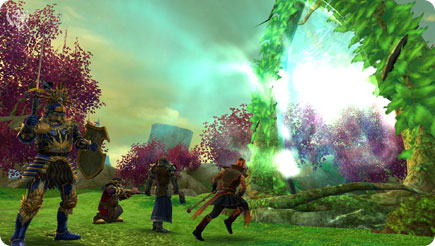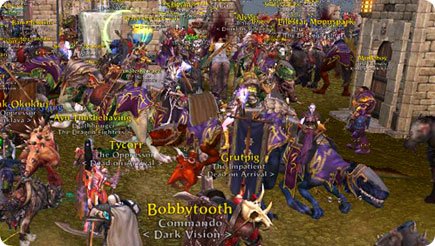
The pillaging of Thorshafn is fun, but the tasks handed out by Dyre and other NPCs are just a small part of a much larger struggle. “WAR is unique in a lot of ways,” Hickman explains, “but if I had to pick one way that it really stands out, it would be our Realm vs. Realm (RvR) system. As you move through the world, you have the option to engage in the numerous, constant RvR conflicts that rage around you.”

Just a Pet. Some Dark Elves are adept at handling creatures like this War Hydra.
With that cue, a rally call sounds and we accompany several players into a scenario called Khaine’s Embrace, which is one of many in WAR. The Elvish god Khaine will unleash his wrath, destroying all characters in the vicinity, if one side can successfully hold both battle objectives for ten seconds. The winners earn victory points for their side — they also score victory points for success in other RvR conflicts, killing enemy characters in player-versus-player zones, completing certain quests, and more. When a realm earns enough points, it takes over additional enemy territory.
“Your large-scale goal is to press the battlefront to the gates of your enemies’ capital city, lay siege to that fortified citadel, break inside, and destroy it completely,” Hickman says. “Of course, you’ll be fighting alongside hundreds of your allies to accomplish that, so those final assaults are pretty awesome to experience.”
“You’ll find times when the world is quite funny, but you’ll also [find] situations that encourage you to embrace your character’s heroic or villainous nature.”
- Jeff Hickman, executive producer

Drawing Them Into the Fray. This Dark Elf Disciple of Khaine is not only skilled with his two swords, but he can also draw life energy out of those foes.
A Twisted Reflection of Humanity
Both sides in the war consist of loose confederacies: the realm of Destruction brings together the human followers of Chaos; savage Orcs, Goblins, and other Greenskins; and the corrupt Dark Elves, while the realm of Order assembles the tough-as-nails Dwarves; the noble Empire; and the ethereal High Elves. The three groups on each side don’t necessarily trust each other, but they understand the importance of strength in numbers.
“Our Orcs aren’t just grim, misunderstood tribal warriors: they’re European soccer hooligans who like to fight because fighting is fun,” Hickman remarks. “Our Dwarves aren’t simply industrious folks who like to stay out of the sun: they’re working class, beer-fueled brawlers with chips on their shoulders, especially about the Elves, who think they rule the world and have never done a real day’s work.”

When the Other Side Comes A-Knockin’. A building under assault.
He adds: “And then there are the forces of Chaos: those guys are all the darkest, most unsettling parts of humanity rolled into one creepy, tentacle-wielding package — like lawyers. But Chaos is distinct from simplistic conceptions of evil: it’s more about disorder and corruption and the disorienting and troubling effect that they can have on us. And when you stab a follower of Chaos, there’s a one percent chance that white mice will shoot out of the wound instead of blood.”
Game Hardware
Check out our systems for your best gaming experience.
- Site: Warhammer Online: Age of Reckoning
- Publisher: Electronic Arts
- Developer: Mythic Entertainment
- Genre: Role-Playing Game
Game Media
“You’ll be fighting alongside hundreds of your allies to [destroy your enemies’ capital city], so those final assaults are pretty awesome to experience.”
- Jeff Hickman, executive producer
Yes, humor is a large part of the game, according to Hickman: “We use dark humor for the same reason Shakespeare did: because relentless darkness can eventually turn your audience off. We also use it because it’s one of the things that sets Warhammer apart from the pseudo utopian/socio-political fantasy of Tolkien and his derivatives. Warhammer has always been built around a dark, comical, and quite twisted reflection of actual humanity.”

Call to Adventure. Four members of the forces of Order embark on a quest.
Endless War Forever and Ever
Khaine’s Embrace concludes and a final leader board appears before we return to Norsca, the zone where Thorshafn is located. We make our way through the village — on its outskirts, several Chaos sorcerers work in concert to summon a demon while the local militia tries to stop them. Several Chaos characters attack the riflemen, participating in one of WAR’s many public quests, where all players in a particular area join forces to accomplish a series of increasingly-difficult tasks. Public quests earn influence points, as do RvR events; influence points bring with them rewards, such as potions or cool pieces of armor.
Public quests form a large part of the game’s storyline, which is broken into chapters. Each of WAR’s six armies has a 22-chapter story that takes you through the game’s four tiers, progressing from relatively easy zones to fiendishly difficult ones. Hickman and his team constantly revise the game’s content, however, so don’t assume that you’ve seen it all by the time you reach the final chapter. (And don’t bother returning to low-level zones to gank opposing characters — you’ll be turned into a feeble chicken as soon as you enter a lower tier.)

A Little Get-Together. Characters prepare for a siege.
“MMORPGs are organic, continuous productions,” Hickman remarks. “Not a day goes by that we don’t find some piece of insight or commentary from our players that eventually finds its way into the game in some fashion. We have a dedicated group of regulars who have been endlessly helpful when it comes to everything from helping us test new content to acting as our ‘eyes in the field’ on a day-to-day basis.”
I ask him about the game’s themes. Hickman scratches his chin, musing on that for a few seconds, and replies: “Aside from endless war forever and ever, I would probably say art, human frailty, the duality of man, and fart gags. Not necessarily in that order. You’ll find times when the world is quite funny, but you’ll also be put into situations that are extremely grim and really encourage you to embrace your character’s heroic or villainous nature.”
With that, he hefts his two-handed axe over his shoulder and heads toward the bridge leading into Wulfsiege, where more adventures await.


